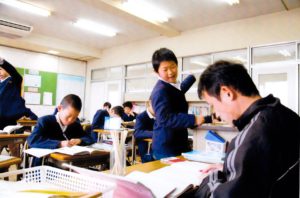It is not. Discrimination by the Japanese government and Japanese people has continued even after Koreans were liberated in 1945, not to mention the harsh violence and discrimination against Koreans during Japanese colonial rule.
 In 1948 and 1949, the Japanese government issued a school closing order to the hundreds of Korean schools throughout Japan. As the Peace Treaty with the Allied Forces had not yet been concluded, the Koreans in Japan were technically still Japanese nationals because they were former colonial subjects. Consequently, the Japanese government argued that Koreans were required to attend Japanese schools. This was the reason behind the closure order. As a result the number of Korean schools drastically decreased however, an intense resistance movement to protect the schools kept some open and ethnic education persevered.
In 1948 and 1949, the Japanese government issued a school closing order to the hundreds of Korean schools throughout Japan. As the Peace Treaty with the Allied Forces had not yet been concluded, the Koreans in Japan were technically still Japanese nationals because they were former colonial subjects. Consequently, the Japanese government argued that Koreans were required to attend Japanese schools. This was the reason behind the closure order. As a result the number of Korean schools drastically decreased however, an intense resistance movement to protect the schools kept some open and ethnic education persevered.
After the San Francisco Peace Treaty went into effect on April 28, 1952, the Japanese government unilaterally declared that Koreans remaining in Japan would “lose” their Japanese nationality. Due to this new stipulation, from Japan’s perspective education for Koreans was neither an obligation nor a right to be protected. At the same time, Korean schools continued to be neglected without any sort of support from the government.
Later, in 1965, the undersecretary of the Ministry of Education issued the official notice to all the prefectural governors that had authority to give “miscellaneous school” status to the schools located in the jurisdiction area. The notice urged the prefectural governors not to give the “miscellaneous school” status to the Korean schools arguing there was no “positive significance to Japanese society in recognizing the Korean schools that cultivate ethnic identity among Korean students.” At the same time, Prime Minister Eisaku Sato also said at the National Assembly that Korean education, independent of the Japanese system, should take place in Korea, not in Japan (December 4, 1965 at the Upper House of Representatives – Special Committee on Treaties and Agreements between Japan and the Republic of Korea). Both these Ministry of Education official notices strongly suggest the intent of the government.
Fortunately, despite this notification, Korean schools were gradually recognized as “miscellaneous schools” and by 1975 all of them had attained the “miscellaneous school” status. However, this was still a lower status compared to the “regular school” status held by Japanese schools, and discriminatory treatment against Korean school was not eliminated. Korean school officials and supporters subsequently continued their campaign and attained some victories including access to students’ fare for commuter passes (rectified in 1994), right to participate in various sports events (gradually resolved in the 1990s), and qualification to take university entrance exams without having to take GED tests (most universities today recognize Korean high school diplomas legitimate after 2004). Today, Korean schools continue to be excluded from the education subsidy of the national treasury and the public scholarship system.
In addition, whenever tensions between Japan and the Democratic People’s Republic of Korea rise, Korean schools and students suffer harassment and violence. Because many female students had their school uniform, chima chogori (Korean traditional dress) slashed on their way to and from school (particularly in 1994 and 1998), the second school uniform resembling Japanese uniform was introduced in 1999 to avoid assaults.
Moreover, in 2009, the racist attack against a Korean elementary school in Kyoto has become a symbolic case where hate speech and unlawful destruction of school property severely threatened Korean education in Japan (The perpetrators were convicted and found guilty in criminal trial, and civil court ordered the payment of $120K and prohibited anti-Korean rallies within a 500-meter radius of the school campus. See Q3 for details).